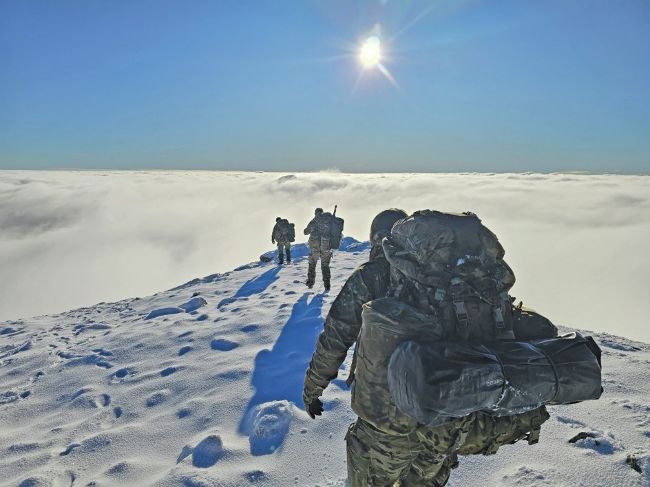40 Commando RM
Mountain Training
by Mne Laubscher, B Coy
In the mountains, physical fitness, mental toughness and Commando values have nowhere to hide. That’s why B Coy decided it was time to swap sunshine for something more demanding. Having trained in Kenya,
Australia and Cyprus over the past year, we needed to get back to where we belong the cold and wet, the places others avoid. Where better than Garelochhead and the West Highlands in the early months of the year?
Scotland’s rugged, unpredictable terrain is no stranger to the Royal Marines. Cold weather and mountainous environments favour small team tactics, demanding highly skilled, fit and resilient individuals. From World War Two operations in Norway, to the Falklands and Afghanistan, Royal Marines have repeatedly demonstrated their ability to thrive in extreme conditions. Inspired by these past operations, we set out to sharpen our skills in one of the toughest environments available.
Training began with vital lessons on crampon use, cold weather tents, proper layering, navigation and emergency casualty procedures. These skills were crucial for our time in the mountains, where the ability to move efficiently and survive in harsh conditions can mean the difference between success and failure.

Operating above the snow line and the clouds
A day was spent conducting Vertical Assault, refreshing our ability to operate in sheer cliff areas, all whilst learning how to use the new weapon system in this environment for the first time.
Over the next few days, we tackled Ben More, Stob Binnein and other ankle breaking peaks, each day adding more weight and distance. The brief moments of calm on top of snow covered summits offered a reward for the burning thighs. However, a week in, Storm Éowyn struck, bringing 100mph winds, which tore off the roof at the local leisure centre, destroying any hopes of a day off in the recovery sauna. More importantly the storm knocked out power to the camp, causing a small fire that was swiftly dealt with. As a result of the fire, all Real Life Support facilities were lost (including freshwater production and ablutions), all routes into the mountains blocked by fallen trees and real life emergency services all rightly focused on repairing the storm damaged National Infrastructure. Regrettably, we were forced to head back down south, leaving many peaks unconquered.